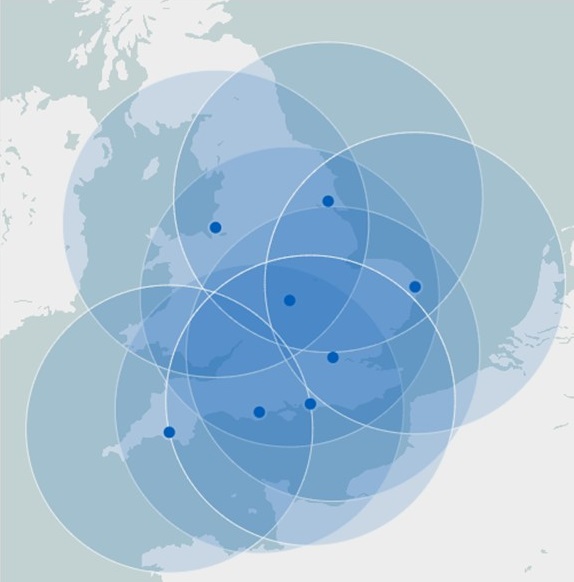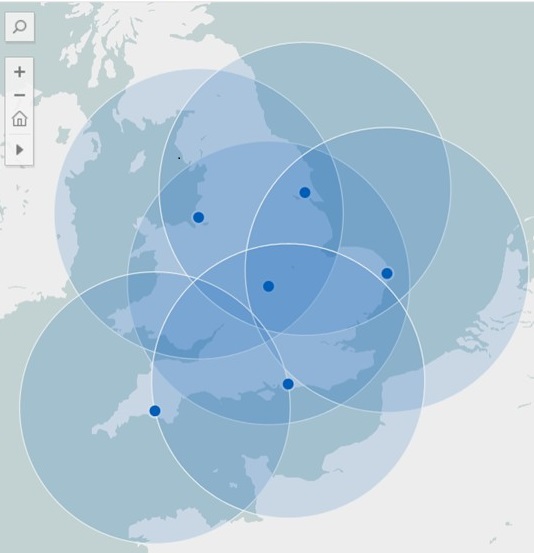Background
Hyperbaric Oxygen Therapy (HBOT) services are commissioned by NHS England for adult and paediatric patients ordinarily resident in England or otherwise the commissioning responsibility of NHS England (as defined in the Manual of Prescribed Specialised Services).
HBOT is the delivery of oxygen at a pressure greater than normal (greater than 100 kPa) so that a higher level of oxygen can be dissolved in the patient’s blood plasma. This takes place within a treatment chamber which may accommodate one or more patients and attendant staff.
The service is provided to clinically appropriate patients for two specific indications in line with current clinical commissioning policy:
1. Decompression illness
Decompression illness arises from exposure to an altered pressure environment, most often from diving. The geographical distribution of cases of decompression illness is determined by the local level of diving activity, and is concentrated around coastal areas, inland expanses of water and the locations of residence of the divers. Airports provide a significant minority of patients usually returning from a diving trip overseas. There is a total of approximately 150 – 200 cases in England per year. HBOT is the only treatment for this potentially fatal condition.
2. Gas embolism
Cases of gas embolism arise from introduction of gas into a patient’s circulation, most often inadvertently during a medical procedure (iatrogenic gas embolism). There are currently approximately 10 cases in England per year. However, this may be an underestimate of the number of actual cases.
Hyperbaric Oxygen Therapy is not routinely commissioned by NHS England for other indications including:
- carbon monoxide poisoning
- necrotising soft tissue infections
- soft tissue radiation damage in patient with a history pelvic irradiation
- diabetic lower limb ulceration (diabetic foot ulcer)
Please note: this consultation only relates to the provision of HBOT for the commissioned clinical indications listed above. The use of HBOT in any other clinical indications is not in scope of this consultation.
Current commissioning arrangements and provider configuration
- Hyperbaric Oxygen Therapy Service has been identified as a nationally retained service and as such is outside the scope of the delegation of specialised services for commissioning by Integrated Care Boards.
- NHS England currently commissions Hyperbaric Oxygen Therapy Services from 7 independent sector providers across 8 centres at a cost of £8.2 million per year (2023/24).
- In order to ensure value for money for taxpayers, a new contract and funding model will be introduced which standardises the cost per patient and the cost per treatment.
- Most services are located close to the coast, with the exception of the centres based in London and the Midlands region.
- Good practice guidelines* set out optimal time to treatment from symptom onset as within 6 hours. Timely access to appropriate treatment is particularly important for patients with gas embolism, most of whom will be acutely unwell and require access to ICU care.
- Providers are required to ensure that clinical staff complete at least ten treatments per year to maintain clinical competency. With some providers treating comparatively low numbers of patients, each staff member completing the minimum number of treatments required to maintain their clinical competency may be challenging. Whilst competency can be maintained through simulations, it is preferred that actual patient treatments are carried out.
- Not all current providers of the service are equipped to provide treatment to critically ill patients as this is not a requirement of the current service specification. This is considered to be an avoidable variation in access to appropriate care for eligible patients which has been addressed through the updated service specification.
*Time to Treatment: Decompression Illness, Health and Safety Executive, 2007
Proposed changes to the service specification and commissioning arrangements
Service specification changes
The service specification change form provides comprehensive information on all of the changes to the specification as part of this revision. The majority of these changes are to provide clarity to the reader. However, there are three areas within the specification which have been updated, that may:
- Improve timeliness of access to treatment for patients.
- Reduce variation in access to care for critically ill patients.
- Ensure long-term outcomes for patients are monitored and reviewed.
These changes specify:
- Transfer to the hyperbaric facility closest to the patient place of presentation is the typical pathway.
- All providers must have the capability to provide hyperbaric critical care in line with the Cox Report category 1. Category 1 states facilities should be capable of receiving patients in any diagnostic category who may require Advanced Life Support either immediately or during Hyperbaric Oxygen Therapy (HBOT).
- Providers are required to offer a follow-up review of patients treated by either phone call, video call or face to face, within 3 months of treatment. This review should include completion of an appropriate qualitative tool, such as EQ-5D.
Commissioned provider reconfiguration
It is proposed that the number of commissioned HBOT centres in England is reduced from 8 centres to 6 centres. The geographical scope of these services ensures that there is no more than 4 hours travelling time (by road) from coastal locations, furthest borders or between neighbouring commissioned HBOT centres and as such meets the recommendations set out in good practice guidelines*. Further information on the modelling underpinning this proposal is appended to this document.
*Time to Treatment: Decompression Illness, Health and Safety Executive, 2007
What is NHS England asking you to do?
NHS England seeks the views of patients and the public regarding changes to both the service specification and the provider commissioning arrangements for HBOT services.
Your input is critical to the development of effective and meaningful national standards and commissioning of high-quality, cost effective, accessible services for patients.
You are welcome to respond on behalf of your group or organisation, or as an individual. You may wish to consult others as part of your response, or you can forward details to other stakeholders. You must declare any conflict of interests relating to this document or service area.
The revised draft service specification set out the changes being proposed, and the equalities and health inequalities assessment (EHIA) set out the potential impact of the changes that are being proposed. The provider modelling information provides a basis of the proposed changes to the number of providers.
- service specification
- EHIA
- change form
- provider modelling
Please note:
- comments relating to non-commissioned indications are out of scope for this consultation and will not be considered
- submit one response per person, duplicate or multiple responses from the same email address will be excluded from the feedback considered
Completing the consultation survey
Complete the consultation survey here
Please submit your feedback by 13 October 2024.
Conflicts of interest
Before completing the survey, you must declare any financial or other interests in any specialised services. For example, if you are responding on behalf of a voluntary organisation and your organisation received any funding within the last two years (including sponsorship or grants) from companies that manufacture drugs or treatments used in the treatment of specialised services, you must declare this. If you are a commercial supplier to the NHS of specialised services, this should also be specified.
Appendix
Hyperbaric Oxygen Therapy Provider Modelling information
This information aims to provide further detail on the proposed reduction in the number of commissioned HBOT centres from 8 to 6. There are two conditions which must be met by the configuration of commissioned providers:
- good practice guidelines* set out optimal time to treatment from symptom onset as within 6 hours. This is especially important for the most acutely unwell patients
- each member of HBOT chamber staff must maintain competency through completing and recording at least 10 patient treatments, simulations, or other relevant training sessions per year
*Time to Treatment: Decompression Illness, Health and Safety Executive, 2007
The modelling below assumes that travel by road of 150 miles can be completed within 4 hours.
Image 1: Current provider location and travel time modelling based on 150-mile radius:
Radial distance (miles) from each centre/border location.
Using radial distance modelling, it has identified that there are currently significant areas of the England where multiple HBOT chambers can be reached by standard road transport within 4 hours. This modelling highlighted that a reduction in centres would be possible, whilst still ensuring access to service within good practice guidelines. It should be noted that some patients are currently transported by helicopter or ambulance with transfer times less than would be experienced by standard road transfer.
Image 2: Radial distance from reduced number of centres (150 miles)
Radial distance (miles) from each centre/border location.
Please note that the current provider location has been used as an indicative/nominal location within region and does not represent actual proposed provider.
Using radial distance modelling, it has identified that a reduction in centres would be possible, whilst still ensuring access to service that is within good practice guidelines. It should be noted that some patients are currently transported by helicopter or ambulance with transfer times less than would be experienced by standard road transfer.



